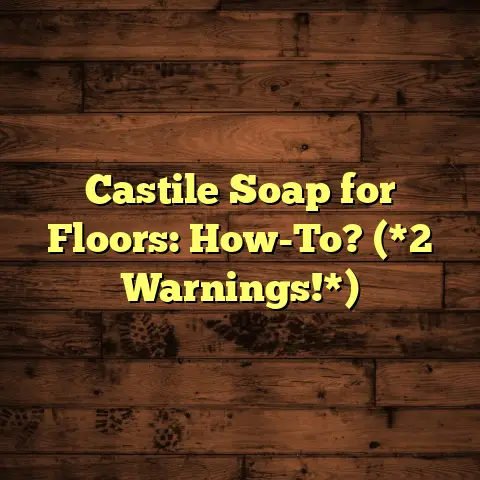Cleaning Sticky Tile Floors? (4 “Don’t” Mistakes!)
Ever feel like you’re chasing your tail?
You clean, you scrub,
and yet, your tile floors still feel sticky?
It’s a paradox, right?
In the quest for a spotless home,
the very act of cleaning can sometimes make our floors
stickier than before.
How is it possible that the pursuit
of cleanliness leads to a messier situation?
I’ve seen it a thousand times.
Homeowners are frustrated,
thinking they’re doing everything right, but the stickiness
persists.
And I’m here to tell you, it’s not you – it’s probably
your cleaning method.
Let’s dive into the world of sticky tile floors and
uncover the common mistakes that make the problem worse.
Knowing what not to do is half the battle!
Section 1: Understanding Sticky Tile Floors
So, what are sticky tile floors?
It’s that unpleasant
tacky feeling underfoot, the kind that makes you want
to wear socks 24/7.
It’s not just dirt; it’s often a residue
that clings to the surface.
Common Culprits Behind the Stick:
Residue from Cleaning Products: This is the biggest offender.
Many cleaning products leave behind a film, especially if they’re not properly diluted or rinsed.-
Dirt Accumulation: Even if you’re cleaning regularly, dirt can build up over time, especially in grout lines.
Improper Installation: Believe it or not, sometimes the stickiness comes from below!
Issues with the subfloor or adhesive can cause problems.-
Hard Water: Minerals in hard water can react with cleaning products, leaving a sticky residue.
Now, let’s talk tile types.
Not all tiles are created equal.
Here’s a quick rundown:
-
Ceramic Tile: Durable and water-resistant, but can still be affected by harsh chemicals.
-
Porcelain Tile: Even more durable than ceramic, with a lower water absorption rate.
-
Vinyl Tile (LVT/LVP): More susceptible to damage from harsh chemicals and excessive water.
-
Stone Tile (Slate, Marble, Granite): Requires specialized cleaning products and techniques.
The type of tile you have will influence which cleaning
methods are safe and effective.
Knowing what not to do
is crucial, because the wrong approach can damage your
tiles and make them even stickier.
This sets the stage for the “Don’t” mistakes we’re about to
cover.
Trust me, avoiding these will save you time, money,
and a whole lot of frustration.
Section 2: The First “Don’t” Mistake – Don’t Use Harsh Chemicals
Okay, let’s get straight to it.
Ditch the harsh chemicals!
I know, I know, it’s tempting to reach for the strongest
cleaner you can find, especially when dealing with a sticky
mess.
But trust me on this one.
Why Harsh Chemicals Are a No-Go:
-
Damage to the Tile Surface: Abrasive chemicals can scratch or dull the finish of your tiles, making them more prone to dirt and residue buildup.
Grout Degradation: Harsh chemicals can break down the grout, leading to crumbling and discoloration.
This creates more nooks and crannies for dirt to hide in.Residue Buildup: Many harsh chemicals leave behind a sticky residue that attracts even more dirt.
It’s a vicious cycle!
Examples of Cleaning Agents to Avoid:
-
Ammonia-Based Cleaners: Can damage grout and some tile finishes.
-
Bleach (in high concentrations): Can discolor grout and weaken tile surfaces.
-
Abrasive Scrubbing Powders: Can scratch and dull tile finishes.
-
Anything with a pH Level Outside of 6-8: Will damage the Tile and Grout.
Safer Alternatives for Cleaning Sticky Tiles:
Warm Water and Mild Dish Soap: A classic for a reason.
Just a few drops of dish soap in a bucket of warm water can work wonders.Vinegar and Water Solution: Mix equal parts white vinegar and water in a spray bottle.
Vinegar is a natural disinfectant and helps to cut through grease and grime.
Important Note: Don’t use vinegar on natural stone tiles like marble or granite, as it can etch the surface.Baking Soda Paste: For stubborn stains, mix baking soda with a little water to form a paste.
Apply to the stain, let it sit for a few minutes, and then scrub gently.-
Commercial Tile Cleaners (pH Neutral): If you prefer a commercial cleaner, look for one that is specifically designed for tile and grout and has a neutral pH.
My Personal Recommendation
I recommend using a steam mop.
The hot steam loosens dirt
and grime without the need for harsh chemicals.
I’ve seen
incredible results with steam mops on all types of tile.
Remember, less is more. Start with the mildest cleaning
solution and gradually increase the strength if needed.
Always
test your cleaning solution in an inconspicuous area first to
make sure it doesn’t damage the tile.
According to the Tile Council of North America (TCNA),
proper cleaning methods can extend the life of your tile
flooring by up to 20 years.
That’s a significant return on
investment for a little extra care!
Section 3: The Second “Don’t” Mistake – Don’t Neglect Regular Maintenance
Think of your tile floors like your teeth.
You wouldn’t just
brush them once a month, right?
Regular maintenance is key
to preventing sticky tile floors from becoming a recurring
nightmare.
Why Regular Cleaning Matters:
-
Prevents Residue Build-Up: Regular cleaning removes dirt and grime before they have a chance to accumulate and create that sticky film.
-
Maintains Tile Appearance: Regular cleaning keeps your tiles looking their best, preventing them from becoming dull and discolored.
-
Extends Tile Lifespan: By preventing the build-up of dirt and grime, regular cleaning helps to protect your tiles from damage and extend their lifespan.
A Regular Cleaning Schedule:
-
Daily: Sweep or vacuum to remove loose dirt and debris.
-
Weekly: Mop with a mild cleaning solution (warm water and dish soap or vinegar and water).
-
Monthly: Deep clean grout lines with a grout brush and a grout cleaner.
Common Misconceptions About Cleaning Frequency:
“I only need to clean when my floors look dirty.” By the time your floors look dirty, a lot of dirt and grime has already accumulated.
Regular cleaning prevents this build-up.“I don’t have time to clean every week.” Even a quick sweep and mop once a week can make a big difference.
Set aside 15-20 minutes and make it a part of your routine.-
“I use a strong cleaner, so I don’t need to clean as often.” As we discussed earlier, harsh chemicals can actually make the problem worse by leaving behind a sticky residue.
The Consequences of Neglect:
-
Stubborn Stains: The longer you wait to clean, the harder it will be to remove stains.
-
Grout Deterioration: Dirt and grime can weaken grout over time, leading to crumbling and discoloration.
-
Increased Stickiness: The build-up of dirt and residue will make your floors increasingly sticky and difficult to clean.
My Personal Tip:
Keep a spray bottle filled with vinegar and water handy.
Spot clean spills and messes as soon as they happen.
This
will prevent them from setting and becoming sticky.
According to a study by the National Association of Realtors,
clean and well-maintained floors can increase the value of
your home by up to 5%.
That’s a significant incentive to
keep your tiles clean and stick-free!
Section 4: The Third “Don’t” Mistake – Don’t Use Excessive Water
Water is essential for cleaning, but too much of a good
thing can actually make your tile floors more sticky.
It’s a delicate balance.
How Excessive Water Leads to Stickiness:
-
Residue Activation: Excess water can reactivate cleaning product residue that’s already on the floor, creating a sticky film.
Grout Saturation: Water can seep into grout lines, carrying dirt and grime with it.
This can lead to mold growth and a sticky residue.-
Subfloor Damage: In extreme cases, excess water can seep under the tiles and damage the subfloor, leading to structural problems and a persistent sticky feeling.
The Mechanics of Moisture:
Imagine your grout lines as tiny sponges.
They absorb water
easily.
If you use too much water when mopping, those sponges
become saturated.
The water then sits there, trapping dirt
and grime.
As the water evaporates, it leaves behind a sticky
residue.
Optimal Water Usage:
Wring Out Your Mop: Make sure your mop is damp, not soaking wet.
Wring it out thoroughly after each dip in the cleaning solution.-
Use a Spray Bottle: For smaller areas, use a spray bottle to apply the cleaning solution directly to the tile surface.
-
Dry the Floor Thoroughly: After mopping, dry the floor with a clean, dry towel or microfiber cloth.
Effective Drying Methods:
-
Microfiber Cloths: These are excellent for absorbing excess water and leaving a streak-free finish.
-
Fans: Placing a fan in the room can help to speed up the drying process.
-
Open Windows: If the weather permits, open windows to improve ventilation and help the floor dry faster.
My Personal Experience:
I once had a client who was constantly complaining about
sticky tile floors.
After observing her cleaning routine,
I realized she was using way too much water.
She was essentially
flooding her floors!
I showed her how to wring out her mop
properly, and the problem was solved.
According to the Institute of Inspection, Cleaning and
Restoration Certification (IICRC), proper drying techniques
can prevent mold growth and other moisture-related problems
in your home.
That’s a crucial consideration for maintaining
a healthy indoor environment.
Section 5: The Fourth “Don’t” Mistake – Don’t Ignore the Source of the Stickiness
Sometimes, the stickiness isn’t just about your cleaning
method.
It’s about what’s causing the stickiness in the
first place.
Identifying and addressing the root cause is
essential for long-term success.
Common Sources of Stickiness:
-
Spilled Food and Drinks: Sticky spills like juice, soda, and syrup can leave behind a residue that’s difficult to remove.
Cleaning Product Residue: As we’ve discussed, this is a major culprit.
Make sure you’re using the right amount of cleaning solution and rinsing thoroughly.-
Pet Accidents: Pet urine and vomit can leave behind a sticky residue and an unpleasant odor.
-
Environmental Factors: Dust, pollen, and other airborne particles can settle on your floors and contribute to stickiness.
-
Cooking Grease: Grease splatters from cooking can accumulate on your floors and create a sticky film.
Troubleshooting the Source:
Identify the Location: Where is the stickiness most noticeable?
This can help you pinpoint the source.Consider Recent Events: Have you spilled anything recently?
Have you used a new cleaning product?-
Inspect the Area: Look closely for stains, residue, or other signs of the source.
Addressing the Source:
Clean Spills Immediately: Don’t let spills sit on your floors.
Clean them up as soon as possible to prevent them from setting.-
Rinse Thoroughly: After cleaning, rinse the area thoroughly with clean water to remove any remaining cleaning product residue.
-
Use the Right Cleaning Products: Choose cleaning products that are specifically designed for the type of mess you’re dealing with.
-
Ventilate the Area: Open windows and doors to ventilate the area and help to dry the floor quickly.
My Personal Story:
I once worked with a client who had a mysterious sticky
patch in her kitchen.
After some investigation, we discovered
that her refrigerator was leaking slightly.
The water was
seeping under the tile and creating a sticky mess.
Once we
fixed the leak, the stickiness disappeared.
According to the Environmental Protection Agency (EPA),
maintaining a clean and dry home can help to prevent the
growth of mold and other allergens.
That’s an important
consideration for protecting your health and the health of
your family.
Conclusion:
Cleaning sticky tile floors can feel like a never-ending
battle, but it doesn’t have to be.
By avoiding these four
common “Don’t” mistakes, you can achieve a smoother, more
effective cleaning process:
- Don’t Use Harsh Chemicals: Opt for gentler alternatives.
- Don’t Neglect Regular Maintenance: Clean regularly to prevent residue build-up.
- Don’t Use Excessive Water: Wring out your mop and dry the floor thoroughly.
- Don’t Ignore the Source of the Stickiness: Identify and address the root cause.
Remember, a little bit of knowledge and the right approach
can make all the difference.
So, next time you’re faced with
sticky tile floors, take a deep breath, avoid these common
pitfalls, and enjoy the satisfaction of a truly clean and
stick-free home.
Are you ready to transform your cleaning habits and say goodbye to sticky tile floors for good?
Call to Action:
What are your experiences with sticky tile floors?
Have you
made any of these “Don’t” mistakes?
Share your stories and
tips in the comments below!
Let’s learn from each other and
create a community of clean and happy homeowners.
Try out
the tips in this article and share your successes – or
additional insights – with the community!





